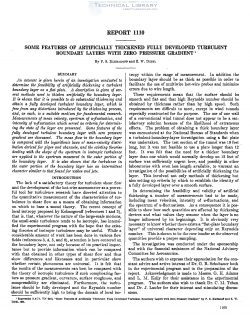naca-report-1110

- Version
- 190 Downloads
- 2.61 MB File Size
- 1 File Count
- September 7, 2016 Create Date
- September 7, 2016 Last Updated
National Advisory Committee for Aeronautics, Report - Some Features of Artificially Thickened Fully Developed Turbulent Boundary Layers with Zero Pressure Gradient

An account is giren here-in of an inrestigation conducted to
determine the feasibility of artificially thickening a turbulent
boundary layer on a flat plate. A description is yicen of see-
eral methods used to thicken artificially the boundary layer.
It is shown that it is possible to do substantial thickening and
obtain a fully dereloped turbulent boundary layer, which is
free from any distortions introduced by the thickening process,
and, as such. is a suitable medium for fundamental research.
llfeasurements of mean relocity, spectrum of u-fluct-uat-ion, and
intensity of u-fluctuation which serred as criteria for determin—
ing the state of the layer are presented. Some features of the
fully developed turbulent boundary layer with zero pressure
gradient are discussed. The mean flow in the boundary layer
is compared with the logarithmic laws of mean-velocity distri—
bution dericed for pipes and channels, and the existing theories
dealing with the shape of the spectrum in isotropic turbulence
are applied to the spectrum measured in the outer portion of
the boundary layer. It is also shown that the turbulence in
the outer portion of the boundary layer has an intermittent
character similar to that found for males and jets.
The lack of a satisfactory theory for turbulent shear flow
and the development of the hot-wire anemometer as a power-
ful tool for turbulence research have directed attention to
the quantitative: measurement of the characteristics of tur-
bulence in shear flow as a means of obtaining information
on which to base a sound theory. The recent concept of
local isotropy proposed by Kolmogorofi' (references 1 and 2),
that is. that, whatever the nature of the large-scale motions,
the small-scale turbulence tends to be isotropic, has intensi-
fied the experimental program with the hope that the exist-
ing theories of isotropic turbulence may be useful.
While a considerable amount of work has been done in various flow
fields (references 3, 4, 5, and 6), attention is here centered on
the boundary layer, not only because of its practical impor-
tance but to provide information which can be compared
with that. obtained in other types of shear flow and thus
show differences and likenesses and in particular show
whether certain phenomena are universal. It is felt that
the results of the measurements can best be compared with
the theory of isotropic turbulence if such complicating fac—
tors as pressure gradient, curvature, surface roughness, and
compressibility are eliminated.
| File | Action |
|---|---|
| naca-report-1110 Some Features of Artificially Thickened Fully Developed Turbulent Boundary Layers with Zero Pressure Gradient.pdf | Download |

Comment On This Post